Beggar’s Chicken from Alex Ong
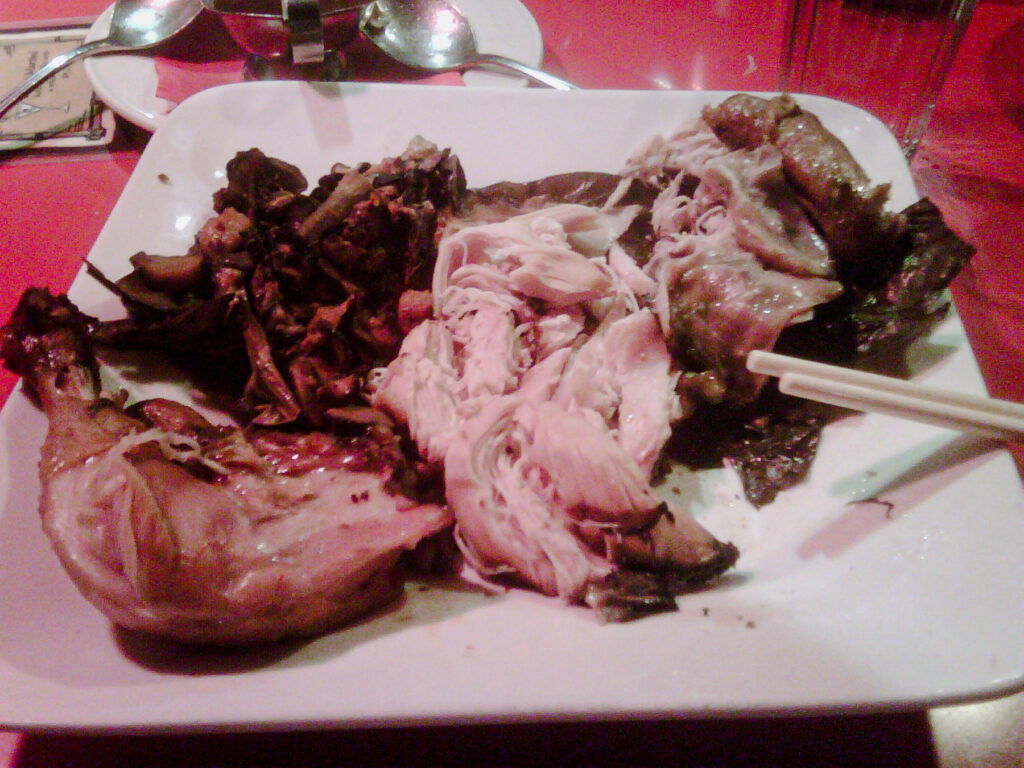
One of the most famous Chinese dishes in the world, this is also one of the more elusive. Perhaps the traditional method of first marinating the bird, then wrapping it in lotus leaves, then sealing it in clay before baking it is too daunting, for not many restaurants actually offer it. One exception is Lou Wai Lou on the shores of West Lake in Hangzhou, China, where the dish has been made since 1848. Another is the late, great Betelnut in San Francisco, where Chef/Owner Alex Ong perfected a recipe for this classic as exciting as it is attainable in the home kitchen.
Brine a 2 1/4 lb. chicken overnight, then marinate in soy marinade.
Chicken brine:
1 gal water
1 C kosher salt
1 C minced ginger
1 C chili sauce
Marinade:
tsp 5-spice powder
2 tsp kosher salt
2 tsp sesame oil
2 tsp sugar
2 tsp oyster sauce
3 tsp Kikkoman soy sauce
2 tbsp Water
2 tbsp mushroom soy sauce or dark soy sauce
Mix all ingredients and rub the marinade inside and outside the chicken.
Stuffing:
10 oyster mushrooms
10 black trumpet mushrooms
1 C wood ear fungus
1 C green beans
1 tbsp ginger, minced
2 tbsp Shaoxing wine
2 tbsp Kikkoman soy sauce
2 tbsp oyster sauce
3 tbsp vegetable oil (to sauté stuffing)
Preheat a wok or sauté pan, add oil and then ginger. Follow withmushrooms and green beans, uniformly cut. Stir fry about 3-4 mins, then add soy, wine and oyster sauce. Cool on a plate to room temp.
Sauce (optional):
3 tbsp Kikkoman soy sauce
2 tbsp oyster sauce
2 tsp sesame oil
6 tbsp chicken stock
Corn starch slurry
Mix all and bring to a boil, then add corn starch slurry. Serve at table.
Assembly:
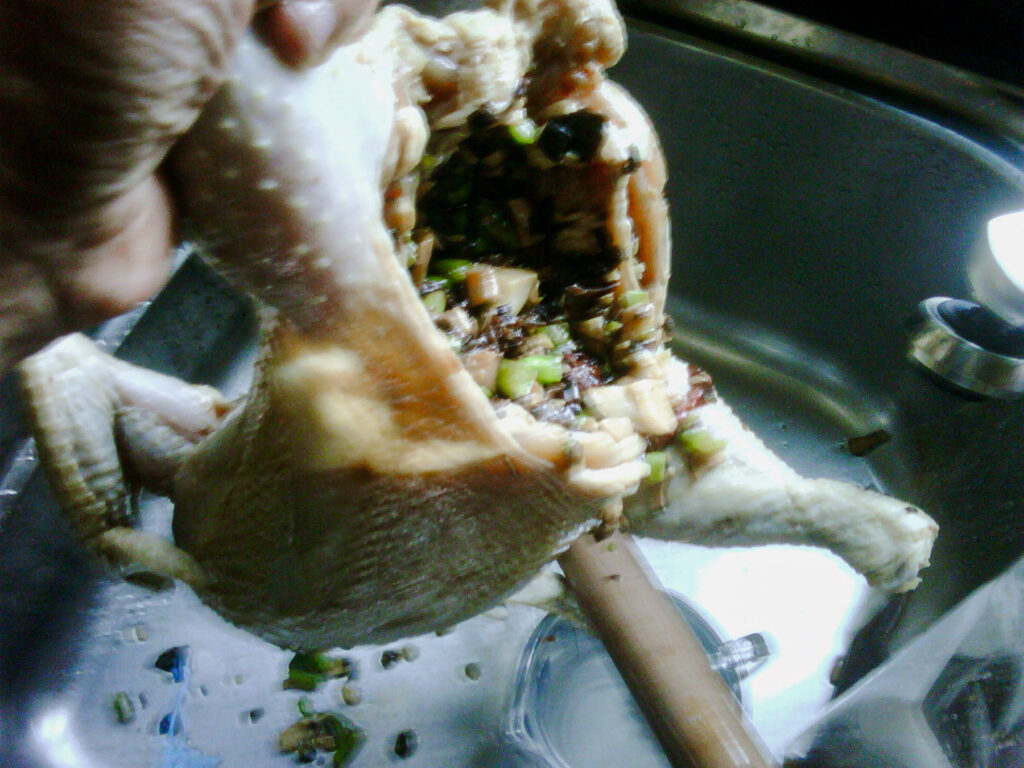
-Stuff the chicken, tie the legs, tuck the wings
-pour some of the juices into the stuffing cavity
-lay lotus leaf on table (after soaking in cold water until pliable)
-place chicken 0n leaf breast side up, wrap and tie.
-roll clay out to about 1/4 inch thick and 15in X 18 in
-place the wrapped chicken on one end of the clay, fold other end over,and seal edges, making sure to repair and seal any holes in the clay. This is important to hold in juice and steam.
-Brush some oil on a baking tray and place sealed chicken on top
-Bake at 350 for 1 1/2 to 1 3/4 hours.
-Remove, and let chicken rest 15 min.
-Plate and present at table
NOTE 1: If clay is unavailable, Lou Wai Lou’s method may be used, which is to wrap the bird in lotus leaf, seal in a plastic baking bag, follow with a second soaked leaf and another baking bag, sealed.
NOTE 2: Lou Wai Lou uses minced smoked ham in the stuffing, and Alex Ong sometimes adds smoked pork belly-both delightful options.
Recipes from Henry Chang
Pork Spare Ribs in Lotus Leaf
These tender steamed ribs, infused with the delicate herbal musk of the lotus leaf, are the creation of Henry Chang, owner and chef of Chang’s Garden in Arcadia, CA. Chang was trained from childhood in an old-school apprenticeship in Taiwan, a place where all China’s cuisines are represented. As a result he is adept in the cooking of every Chinese province. Lately the cuisine of Hangzhou has captured his creative attention, and he has opened this restaurant to showcase the subtle literary-themed dishes of that city. One clue to his success: while the English name of the place is Chang’s Garden, nobody calls it that in Chinese. In Chinese it’s Lou Wai Lou, the name of one of the most famous and venerable of Hangzhou restaurants.
These have to steam a long time, but are easy to make.
1 lb pork spare ribs
Seasonings: 2T chopped scallion; 1 T chopped ginger;
2 dried lotus leaves
Seasonings: 1T each soy sauce, oil, sugar, soybean paste
rice powder scented with 5-spice
Seasonings: 1/2 T sesame oil
Cut spare ribs into pieces 1 1/2 inch wide, 2 inches long, then marinate in seasonings 1/2 hour. Cut lotus leaves into eight pieces and soak in hot water 20 min. Remove marinated ribs and discard scallion and ginger. Add rice powder and thoroughly mix with rib pieces. Divide ribs into eight small portions. Place each on a soaked lotus leaf, fold and roll to make a package. Place with the smooth side down in a bowl or deep plate. Steam over high heat for two hours until tender. Put a serving plate face down over the bowl and turn over. Serves 4.
– courtesy Henry Chang
NOTE: I think Henry does something to de-fat his ribs before he begins. At the very least I would trim every speck of visible fat off, because the rib is cooked in an enclosed package.
Also, in the last few years, Henry’s method for this dish has evolved in his own restaurant. These days, he is using a little more sticky rice around the rib, and has also taken to adding some red pepper flakes.
Snow Cabbage with Bean Sheets
An amazing example of a vegetable dish which is completely virtuous and utterly delicious at the same time, Snow Cabbage with Bean Sheets was originally created by Taiwanese chef Henry Chang for his restaurant Juon Yuan in San Gabriel, CA. Juon Yuan is no more, but luckily he has kept this marvelous dish on the menu at his current restaurant, Chang’s Garden, which showcases the cuisine of Hangzhou. The ‘bean sheets’ look and taste like wide, flat noodles but are actually tofu skins, a by-product of the tofu-making process. They have more protein and less carbohydrate than pasta. ‘Snow cabbage’ is mustard greens which have been very lightly salted. While this delicately flavored dish sounds like something which is merely good for you, most people find it impossible to stop eating once they have taken a bite.
4 oz ready-soaked tofu skin *
4 oz preserved and salted mustard greens
4 oz fresh braised soybeans *
scallions
salt, pepper, dash of cooking wine
* Bean sheets (also called tofu skins) and lightly preserved/salted mustard greens (‘snow cabbage’) can be bought in many Asian grocery stores. Bean sheets must be soaked in water before use. If salted mustard greens cannot be found, you can buy mustard greens and macerate them yourself. For fresh braised soybeans, use shelled edamame, which are widely available fresh and frozen. Dry sherry is a reasonable substitute for Chinese cooking wine.
Cut soaked tofu skins into strips like wide noodles. Heat peanut oil in wok and cook scallions until fragrance rises. Add tofu ‘noodles’ and mustard greens. Season with salt, pepper and cooking wine. Cook over medium heat for a few minutes. After five minutes of cooking add fresh soybeans and stir until liquid is absorbed, then serve.
– courtesy Henry Chang
NOTE: Thanks to the reader who e-mailed me to point out that the saltiness of the mustard greens should be checked before proceeding with the dish! If the greens are too salty, washing thoroughly in cold water and patting dry will help.
Recipes from Yangshuo Cooking School

Let’s face it, some of the recipes I’ve put up on this site for dishes described in The Last Chinese Chef are difficult to replicate. So here, for your delectation, are some I have collected from the Yangshuo Cooking School which have become keepers in my kitchen. Happy cooking!
Yangshuo Country Eggplant
I learned this deliciously satisfying vegetable dish at the lovely Yangshuo Cooking School in rural Guangxi Province. This is a scenic area very close to Guilin, with lazy mirror-smooth rivers and karst-spire hills. The school itself is located in a renovated farmhouse with a vegetable garden outside and soul-stirring views through the wood-latticed windows. The dishes taught represent the peasant cooking of the area, like this dish, hardy, piquant, and so good my kids have been spotted vacuuming up leftovers the next day.
Abt 1 lb Asian eggplant (or 3-4 long ones)
abt 6 T oil
1 red sweet pepper cut into strips
1-2 oz ginger, smashed and minced ( a peeled 1.5-2” chunk)
2-3 cloves garlic, smashed
2-4 spring onions, sliced in julienne style strips
salt to taste (1 tsp or less depending on soy sauce and bean sauce)
3-4 t soy sauce (a splash is the right attitude here)
2 t oyster sauce
splash of water (1/4-1/3C)
2 T chile/black bean sauce or to taste. With this ingredient you can make it more or less hot. And you can really use any chile/bean paste if you do not have chile/black bean.
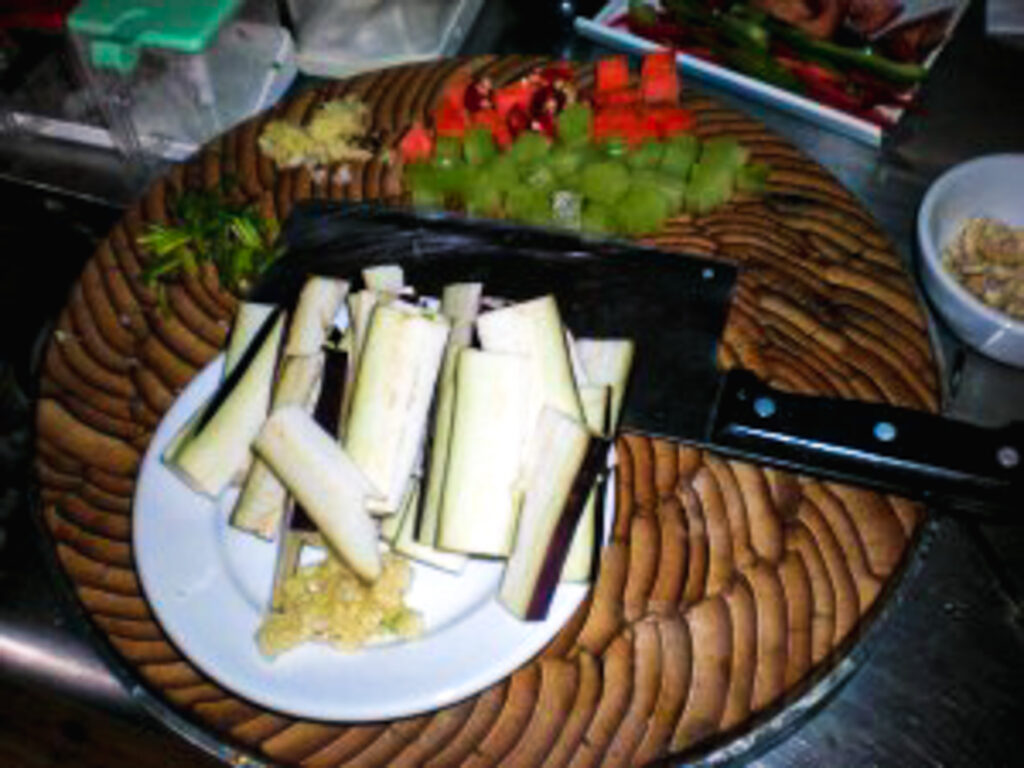
Cut eggplant in sections about six inches long and then in half again to 3” tubes. Halve the long way, then turn flat cut side down on board and halve again the same way. For the final step turn each wedge again until the round skin side is down, then work from the apex downward with the cleaver to cut wedges. I find cutting an average halved eggplant of the tubular Asian type into 6 wedges to be about right. (See photo on left.)
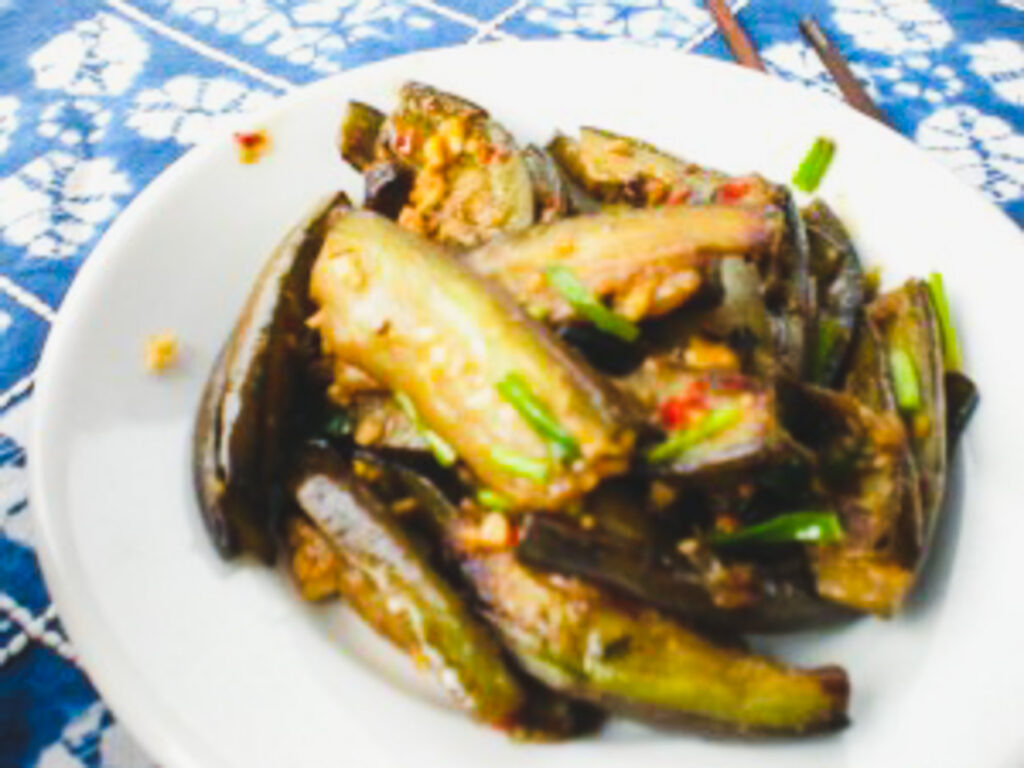
Heat wok until smoking, Add oil. Let oil come to smoking, add eggplant, and reduce heat to medium. Fry until brown and cooked through. Move to side of wok. Keep heat medium. Add garlic, ginger and red pepper. Fry until fragrance rises. Add chile/black bean sauce.
Then add the splash of water. Change to high heat.
Guide eggplant back into the vegetables. Add salt and oyster sauce. Cook until the water’s gone. At the very end fold in the spring onions and serve. (Personally, I also scatter fresh cilantro leaves over the top.)
NOTE: The next day my fellow students and I were commiserating about how much oil eggplant soaks up; wasn’t there a way to do it with less? I asked the teacher, Xiao Fan. She said she too does not like to use so much oil day in and day out. For regular home meals, she uses much less oil, and then when the eggplant inevitably drinks it in and starts to catch, she completes the first step by adding tiny, gradual amounts of water as needed to keep it from sticking.
Steamed Stuffed Vegetables or Edible Flowers
Consider the dumpling. What is it but seasoned minced meat (usually), wrapped in some kind of dough? Why not apply the idea to stuffing other things, for a treat which is at once lighter and more complex? This is what the country people around Yangshuo do, stuffing and steaming pumpkin flowers, mushroom caps, and even those little golden-fried tofu balls or squares you can find in Asian markets.
12 oz minced pork
6 T chives, chopped fine
4 T oyster sauce
1 t spoon salt or to taste.
Other herbs can be added. Mint or cilantro are very nice.
Mix ingredients. If using mushrooms remove stem ( it may be chopped into the mince) . If using little fried tofu balls carefully tear a small hole with your finger; there is space inside. You can use any edible flower such as squash or pumpkin. Miniature sweet peppers would work.
Using a spoon, place filling in vegetable and then use the handle of the spoon to stuff it down. If using mushrooms or tofu balls, stuff firmly. For the more delicate squash or pumpkin flowers, be gentle but try to fill it.
Place in steamer basket or plate on upended cup in the wok, cover, and steam for 15 min.
Pao La Jiao (Pickled Chiles)

The pickled chiles mentioned in the previous recipes are a ubiquitous condiment in northern Guangxi Province, though you can always substitute fresh ones (in smaller quantity). Preserving the chiles makes them tender to the bite and less hot, so they can be enjoyed more as a vegetable than a heat-raiser. After pickling, a hot red chile like the one in the dish shown here can be eaten as a vegetable. Want to try it at home? Here is chef Cheng Jing’s recipe:
1/2 kilo fresh hot chiles
same weight of water 1/2 kilo
salt – a little less than 1/4 kilo. Actually close to 1/8.
Wine (should be white rice wine, meaning sake better than shaoxing) double the weight of the salt.
Close tight in a jar. Use a sheet of plastic wrap under the lid to make it extra tight.
Wait one month. The chiles will keep on the shelf for half a year.
If you want it faster, add a little vinegar, and then wait 20 days.
Caution – never touch with oil. This will cause them to spoil. When retrieving chiles from the jar always use clean wooden chopsticks. Never retrieve with a metal implement such as fork or spoon. Do not use plastic chopsticks either. Metal and plastic are thought to not be completely free of oil after washing.
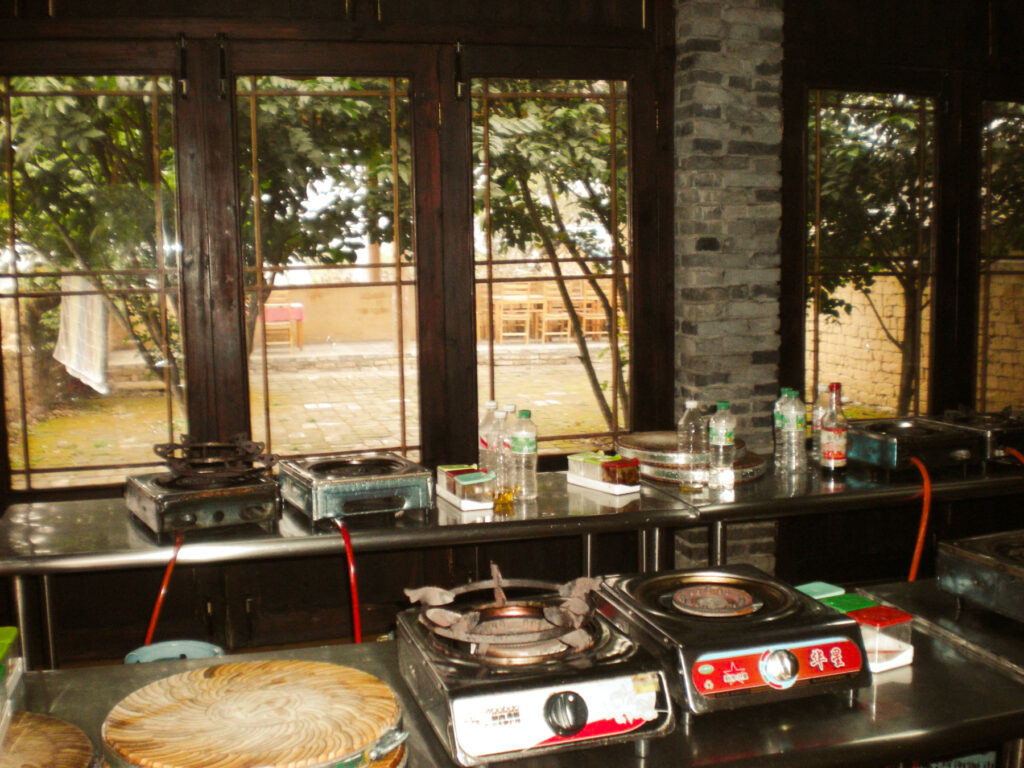
Cheng Jing even cautions that you should not trim the fresh chiles with scissors. Scissors tend to hold tiny amts of oil. Use a very clean cleaver to trim the green end (they leave the tiny green nub on) and then wash the chiles very well and fully dry, not with towel but in sun (or maybe on counter), before proceeding. Don’t handle them. Your hands have oil. Handle with clean wooden chopsticks.
Xiao Fan, the lead cook at the Yangshuo Cooking School, is famous for this sauce which is ingenious, easy to make, and transforms anything from a steamed or grilled piece of meat or poultry to a cold tofu salad. Since Gourmet refined this recipe in their test kitchen and published it, I will give you their version:
Xiao Fan’s Special Sauce
1 1/2T peanut or vegetable oil
4 cloves garlic, minced
3-4 fresh hot minced Thai chiles, including seeds
1/2 C coarsely chopped cilantro
1/4 C water
1 t soy sauce
1 t rice vinegar (not seasoned)
1/4 t salt
1/4 cup stock or meat juices (if you are cooking meat for this sauce)
Heat a wok or large heavy skillet (not nonstick) over high heat until smoking, then drizzle oil down side of wok and swirl to coat. Reduce heat to medium, add garlic and stir-fry 15 seconds. Add chiles and stir-fry 15 seconds. Add cilantro and stir fry one minute. Stir in remaining ingredients and simmer one minute. Drizzle only the liquid over the dish or, to make it spicier, add some of the solids. (Courtesy Fan Nianfeng, Yangshuo Cooking School)
Recipes from Yunnan
Ghost Chicken & Sichuan Pepper Oil
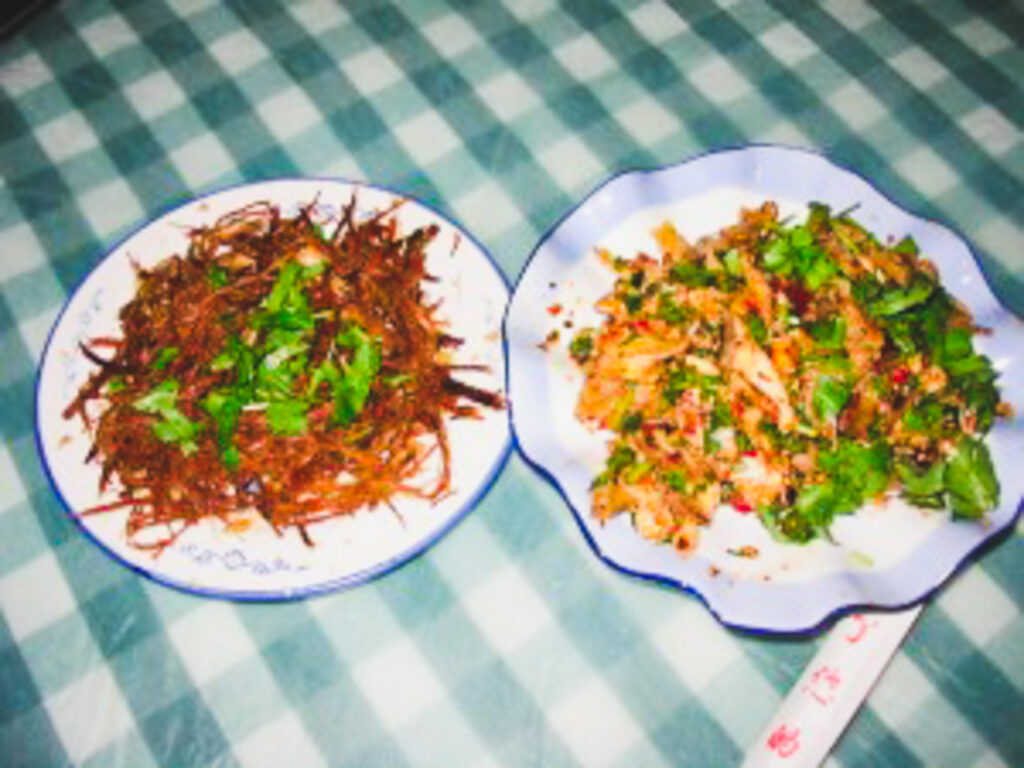
In my house, this is the single most popular dish I have brought back from China. We have it often. The name comes from the ancestor-worshipping practice of the Dai minority people who, after offering a ceremonial boiled chicken to their dear departed, sensibly shred the meat to make this high-octane cold dish. It’s a great do-ahead when you want to leave food in the fridge for the kids or take something different along to a picnic. I found it at Baita Daiwei Ting, a tiny Dai restaurant in Kunming, and their version is the dish on the right. The Dai people live in southern Yunnan near the Laotian border; note the presence of lime, rare in Chinese cooking.
2 chicken breasts, skin-on and bone-in, about 1.5 lb
1.5 t fresh lime juice
1 t chile bean paste with garlic; Lan Chi if you can find it
1 t red-chile oil, or to taste (this is available in Asian markets)
1 t Sichuan pepper oil (see below)
1 t rasp-grated fresh ginger
1/2 t rasp-grated garlic
1/2 t minced fresh mild long red chile
1/2 t salt
1 C fresh cilantro sprigs
Steam chicken. When cool enough, coarsely shred and discard skin and bones. Stir together all other ingredients except salt, adding up to 2T steaming liquid from chicken if it seems needed. Dress the chicken, add the salt gradually to taste, and toss with cilantro sprigs just before serving.
Sichuan Pepper Oil
Sichuan pepper, hua jiao, the dried berry of the Chinese prickly ash, has a hot and also temporarily numbing effect on the tongue. For this reason the primary flavor profile of Sichuan is called ma-la, numbing and hot, which refers to the combination of hua jiao and hot chile peppers. Used on its own, at home, Sichuan pepper can be a bit much. The test kitchen at Gourmet came up with this alternative, which is easy to make and keeps for 3 months in the refrigerator. You will need an electric coffee/spice grinder.
2 t Sichuan peppercorns
1/4 C peanut oil.
Pulse the peppercorns to a coarse grind.
Heat oil with peppercorns in a 1-1.5 qt heavy saucepan over medium heat, swirling occasionally, until peppercorns appear a shade darker, about 1 min. Transfer to a heatproof bowl. Stir before using. Store in a covered glass jar.
Bean Jelly
Bean Jelly is a signature food of Yunnan Province, with every town having its special version made from a local bean (producing a different color jelly). Here in the U.S. you have only one choice at Asian groceries–dried mung bean starch, which makes a snow-white jelly. This is an unflavored base food, like pasta, which shows off any number of sauces; it has the consistency of very firm jello and is much lower in calories and carbohydrates than pasta. You can cut it into any shape or shave it into ‘noodles’. It is firm enough to hold up to stir-frying, although as this dish has traveled across China in the last decade, showing up on restaurant menus and in home kitchens, it has become most popular in the cold form described below.
Yunnan is adjacent to Sichuan, hence this Yunnan-style sauce has the ‘ma-la’ flavor.

Make jelly:
2 3/4 C water
1/2 C mung bean starch
1/2 t salt
Bring water, bean starch, and salt to a boil in a 2-3 qt heavy saucepan, then boil, over moderate heat, stirring constantly, until it turns thick and translucent. Transfer to an 8″ square baking dish (or other mold of your choice) and cool to room temperature. Cover with plastic wrap and chill until firm, about 2 hours or up to one day.
Make sauce:
2 T soy sauce
1 T Chinese black vinegar
2 t sugar
2 t Sichuan pepper oil
1 t red-chile oil
1 t rasp-grated ginger
1/2 t rasp-grated garlic
3 large scallions (white and pale green part) cut into shreds
1 3-inch piece of daikon, peeled and cut into matchsticks
For garnish: shopped scallion green tops, coarse-chopped roasted peanuts
Mix together sauce ingredients. Run thin knife around side of jelly to loosen, unmold on cutting board. Cut into strip shapes. Gently combine with sauce, scallions and daikon; top with sliced scallion tops and peanuts.
Salt-Roasted Broad Beans
Fried salted broad (fava) beans are a popular snack and drinking tidbit in China, which led to me placing them on a fictional table somewhere in The Last Chinese Chef. Yet when a reader wrote to me asking for the recipe, I was flummoxed. I had never thought of making them. In China they are sold in most convenience stores; it would be like deciding to make potato chips. However, people do that… soon, the idea began to appeal to me. Commercial broad bean snacks in China are invariably deep fried. Why couldn’t I roast fava beans in the oven with a little olive oil instead?
I adapted the following recipe from one I found on the internet. This is the plain version–olive oil and salt, but your imagination is the limit as far as additional seasonings are concerned.
One problem–and it is a problem with the commercial version of the snack in China too–is that the beans don’t cook evenly and every so often you bite into a bean that is hard as a rock. If, in the boiling step below, you let the beans ‘explode’, they will roast up light and crispy, never hard. Though they erupt they will still hold together in the roasting process.
1 C dried fava beans
1 t salt or to taste
about 5 t olive oil (or your choice)
Soak beans 6-8 hours or overnight. Drain, rinse, cover with cold water. Bring to a boil and boil until the beans pop (something like a corn kernel.) They won’t all open at the same time, so remove when you feel most are ready.
Handling the beans gently now, drain and let them cool a little, then toss in the oil and salt and spread on a baking sheet to roast in a 350-degree oven until they are golden brown (around 25-40 min, but check and taste often; you don’t want the center of the bean to still have any moisture after cooling ). Evenness of cooking time may still be a problem and you may have to discard some; pick over before serving.
